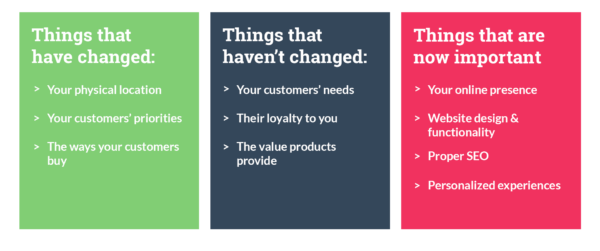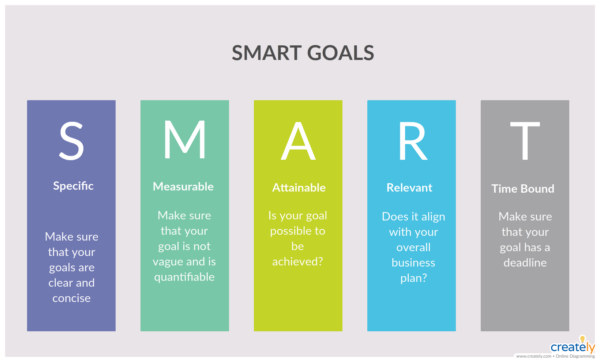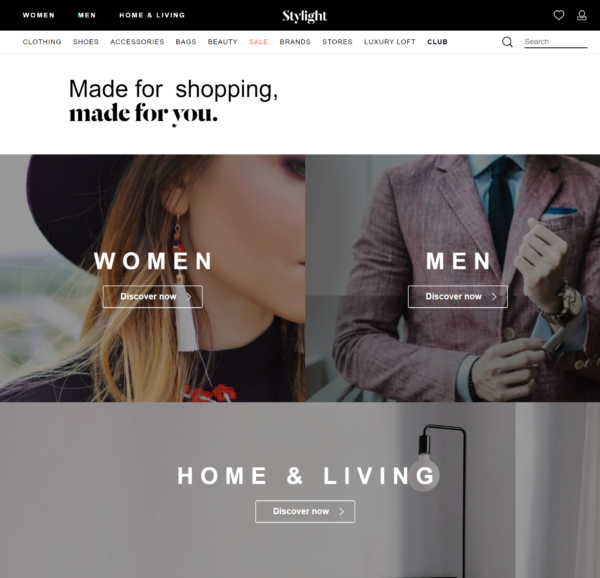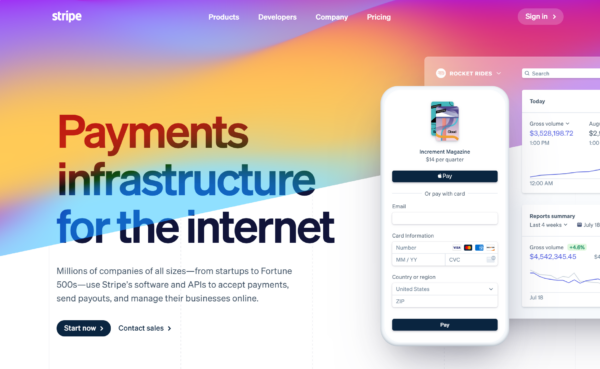2020 has been a tough year for local stores.
And for two obvious reasons: quarantine and social distancing.
The retail world is now forced to transition brick-and-mortar businesses to online stores.
But that’s not easy.
Changing your brand face, the way you sell, and the way you reach out to customers all at once is as complicated as it sounds.
However, it is possible.
And here, you’ll learn how you can handle digital transformation without scratching your head wondering, what to do exactly.
The entire process, divided into 3 phases.
So let’s get right into it.
Phase 1. Setting up Your Online Business Fundamentals
The first step is to have a solid business structure. It doesn’t matter how strong your local business is, it is always good to revisit these fundamentals and understand what has changed.

Let’s take a look at the following.
Define your business goals
You’ll likely need to re-evaluate your business goals.
When businesses are forced to adapt due to sudden changes, it is logical that your goals may as well fall too short or too unrealistic.
In the online business space, SMART goals are the standard, and it stands for:
- Specific. Telling exactly what you want to accomplish.
- Measurable. So it’s easy to know your progress and make decisions.
- Achievable. Realistic for your business to accomplish.
- Relevant. Goals that add progress and growth, not vanity metrics.
- Time-Bound. With a deadline. Otherwise, goals are just a dream.

Once you’ve set your new goals, you’ll see some light at the end of the tunnel.
Define your target audience
If your location is a strong sales point (like “the only cloth store with USA products in Omaha”), then you may consider focusing on local buyers.
On the other hand, if your business can stand out from the global crowd because of your unique branding, offer, etc… Then going big could be a good option too!
It is important to define who your ideal customer is, not only by location but by their personality, behavior, psychographics, demographics, feelings, and desires.
For this, it is highly recommended to create a buyer persona. So you can build your business around them, and not you.
Define your products
When going online, dropshipping becomes a tempting option for you, as you’ll no longer need to deal with inventory space and all sorts of logistics, it’s all managed by your dropshipping supplier.
Dropshipping is a good option if your products are replaceable and you can find products with equal or better quality from dropshippers.
But if you sell unique products that are irreplaceable and unique for your brand, then you may want to deal with all the shipping and packaging.
It all depends on the kind of products you want to sell.
Start with a handful of products to sell in your online store. The products that represent your brand and solve your target audience problems — that’s the important step.
Be aware, though; not every product can be sold online. There’s a list of products restricted to sell online, depending on your region’s regulations.
Revisit your brand identity
Although branding is more of a marketing strategy, it is one of the basics you need to take care of early.
Building up your brand early will save you tons of headaches and get you the long-term results earlier.
To build a brand, you’ll need to determine:
Your brand mission and core values.
Your brand visual aesthetics.
Your brand personality.
Your brand voice.
Branding is about giving a constant message through different communication channels, forging relationships with customers. So if you start doing it early on, it will surely become a valuable asset for you.
Phase 2. Creating an Optimal Website for Your E-Store
Building an optimized website is essential so your customers can reach out to you, get to know you, and buy from you.
Basically, your website will become your actual store. That’s how essential it is.
To create a website that sells, you’ll need to take care of a series of things:
Domain name, web hosting, and platforms
First thing first, you need to buy a domain for your brand. There’re plenty of sites where you can buy domains, such as NameCheap. I’ve even recommended it as the cheapest .com domain for 2020.

SOURCE: namecheap.com
(Pro tip: don’t waste too much time thinking about domain name ideas).
Domain names are fairly cheap. But what you’ll need to decide early on are the hosting and your E-Commerce platform.
You can either use specialized platforms like Shopify or BigCommerce (no hosting needed for these).
Or, stick to WordPress E-commerce plugins like WooCommerce.
They’re all great options. It will depend on your business and how much control you want to have over your website. Choose what fits you best.
Pro tip: I recommend checking out Designmodo for solid resources on building websites.
Website structure
Be clear about the pages you’re going to include in your website and their purpose.
Remember, each page should be heavily optimized for customers to take the next step to buy.
The most basic e-commerce pages include:
- Homepage
- About page
- Product pages
- Checkout page
- Thank you page
These are the most basic and essential pages.
Blogs, buyer reviews, and other features are optional (though recommended).
You can take inspiration from other websites like Glossier or Stylight. And see what kind of content and tools fit best with your brand.

Payment options
People love buying online with cards.
Make sure you’ve got the right platforms so you’ll be able to accept *at least* credit cards and PayPal (eChecks and BitCoin are extra).
Where will that money go, and how can you get it? Well, if your country supports it, Stripe is the perfect payment processor for e-stores. And setting it up is as straight-forward as opening a PayPal account.

SOURCE: stripe.com
If you can’t use Stripe, 2CheckOut and Braintree may work for you as well.
What’s truly important is to make it easy for visitors to buy and check out.
Shipping method
There are many ways to handle shipping.
You can opt for manual shipping, where you need to send notifications, track orders, and deal with couriers. With the advantage of offering in-store pickup to local customers.
Or, use e-commerce platforms like ShipBob an e-commerce shipping software that it easier for you to automate shipping of your business.

SOURCE: shipbob.com
And if you are into dropshipping, well, then there isn’t much to worry about.
However, it is important to reduce shipping costs as much as possible. According to research, 25% of online customers often leave their carts when they see additional unexpected costs in the check out page.
To solve this, make the total price clear on the product pages so customers are aware of the price right from the beginning, taking the unpleasant surprise out of the equation and increasing your sales.
Copywriting and web design that works
Building an optimal website that sells is not easy.
You’ll need to test multiple versions of the same page, make sure they perform, and often hire professionals to handle it for you.
Two of the most important components of a high-performing website are the copy and the design. So, if you’re not working with a marketing team right now, it won’t hurt to start asking around your network for great copywriters and web designers.
Your main goal here is to get better results, not getting vanity numbers like traffic or clicks.
The copy and the design are not meant to be artistically impressive or clever — but clear, compelling, and action-driving.
Don’t forget that the output is what truly matters here.
But don’t worry, though, good copywriters and designers already know this.
Phase 3. Putting Your Online Marketing Strategy Together
If you want your website to work. You need to embrace digital marketing.
Essentially, the main goal of marketing is to acquire customers.
Basically, you invest in marketing to get customers that will hopefully bring you more money than your initial investment, getting you ROI.
How you approach marketing depends on the way you acquire customers, your sales funnel, and your strategies.
And for customer acquisition channels, there are two categories: Inbound Marketing and Outbound Marketing.
3.1. Inbound Marketing
According to Hubspot, Inbound marketing is:

SOURCE: Hubspot
Inbound is about building relationships with your audience, while outbound is a direct approach that takes place out of your business space.
In the digital marketing space, inbound marketing often includes:
- Social Media Marketing: Almost half of social media users use it to find products. You can use social media to forge relationships with your target audience and build your brand authority. Being consistent and interactive with your followers is key to succeed at it.
- Content Marketing. Creating content such as blogs, whitepapers, infographics, podcasts, or even compelling videos can be your main way to increase brand awareness. In fact, according to the Content Marketing Institute 2019 Report, 82% of B2C marketer’s top goals are to create brand awareness and build relationships with customers. So don’t use content to sell right away, use it to help your audience solve problems that are related to your niche.
- SEO (Search Engine Optimization). Optimizing your website for SEO allows your brand to be more visible. Create an SEO strategy where you aim for keywords that are relevant to your business. A well-thought-out strategy will get you thousands of organic traffic. The most important SEO tip is to not optimize your site only for Google’s algorithm, but for the search intent too. Your website needs to bring the answer your target audience is actively looking.
- Email Marketing. Building an email list is the best way to get closer to your audience and close sales. Since people who have previously subscribed to you are more open to reading about your offer without getting annoyed.
You can do almost everything with email.
Sending notifications for orders and abandoned carts
Providing value with newsletters and 7-day courses
Promoting your products by offering discounts and recommended products.
Learning email marketing is a whole discipline by itself.
Inbound marketing also includes tools like chatbots and customer support. So don’t overlook other marketing channels that may fit your brand as well.
3.2. Outbound Marketing
Outbound marketing interacts directly with prospects outside of your platforms and brings short-term results in raw sales.
In short, you invest 1$ today to get 2$ tomorrow.
Outbound is also used to expand brand awareness through website ads, TV/radio commercials, and every 3rd party platform that allows you to promote your brand for a certain cost.
The most common outbound channels include:
- Google Ads. Also known as SEM (Search Engine Marketing), it puts your page on top of the search results for a certain cost (a cost that depends on the competition). And like SEO, there’re strategies and tricks. Every business should do their math before investing a dollar on this.
- Social Ads. Every social platform (Facebook, Twitter, Instagram) allows you to put ads on its platform. Each platform has its own specific format and a set of rules you should follow, hence why people can specialize only in “Facebook ads” or “ Instagram ads”. The best way to approach social ads is by choosing the right platform where your ideal customers hang out the most, and heavily target your ads on them — maximizing your sales per dollar.
- PPC/PPM/PPS ads. Stands for pay per click/impression/sales. Here, you pay, so websites that are relevant to your business put banners or videos advertising your brand. The websites get money from every click, mil impressions, or sale that your ads make. So it is wise to choose what options suit your business best.
- Cold email outreach. An old-school way to reach out to potential customers is by just sending them emails. And different from what other people think, cold emails still work. The key here is to make it short, personal, and credible; otherwise, you’ll get ignored or sent to the spam folder.
Upgrade Your Business to The Digital Era
No business is 100% safe. However, your business will be more reliable if you adopt the new technologies and trends, and use them to your advantage.
Building your business digital presence will give you the flexibility you need to adapt. And as you’ve seen, it can be done if you take these 3 phases:
Building your business fundamentals.
Optimizing your website and platforms.
Following a digital marketing strategy.
It is easier said than done, but this will hopefully give you a roadmap and some orientation to transition your brick-and-mortar business to an online store successfully.
So don’t hesitate and embrace digital transformation.
Digital & Social Articles on Business 2 Community
(57)






